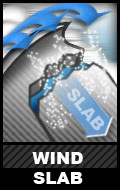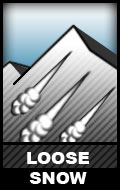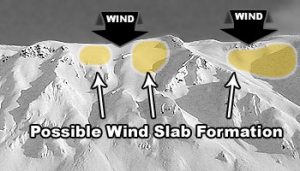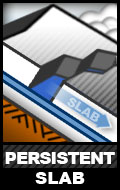Avalanche Danger Forecast
Issued Monday, January 25, 2021 at 10am for the greater Anchorage area Western Chugach Mountains (i.e. Chugach State Park). View map of primary forecast area here.
Avalanche danger will be moderate through this forecast period.
Avalanche danger will decrease through Wednesday to the lower end of the moderate spectrum due to light winds, cooling temperatures, and no precipitation.
Avalanche danger will increase Thursday due to increasing winds and chance for a few to several inches of new snow in the alpine.
The greater Anchorage area Western Chugach Mountains received several inches of new snow with generally light winds Saturday-Sunday. This snowfall greatly improved surface conditions and riding is excellent.
Generally sunny, clear, and calm weather is forecast through Wednesday. This will provide a great window for enjoying Chugach State Park pow with decreasing avalanche danger.
Thursday is forecast to bring cloudy skies, increasing winds, and a chance for more snow. Expect avalanche danger to start increasing then.
Avalanche Problems:
 Wind slabs up to D2 in size are possible above 2500′ on leeward terrain steeper than 35º.
Wind slabs up to D2 in size are possible above 2500′ on leeward terrain steeper than 35º.
Winds accompanying the Saturday-Sunday snowfall that deposited several inches of new snow in the alpine were generally light. The Saturday-Sunday snow is generally unmolested powder that is expected to provide excellent riding conditions through Wednesday.
In some upper elevation leeward areas that powder has been consolidated into cohesive soft slabs by moderate winds.
While natural avalanches are unlikely this forecast period (not completely ruled out for Thursday due to the weather changing then), human triggered wind slabs are possible.
Pay attention to the wind scouring and loading patterns in the upper elevations to better understand where potentially reactive wind slabs may exist. Wind slabs are most likely to exist below corniced areas and along the lee sides of ridges and cross-loaded features like gullies:
Active wind loading, recent natural avalanches, and shooting cracks are red flag indicators of wind slab danger. However, these indicators aren’t expected to be present through Wednesday with the clear and calm weather (they may be present by Thursday if danger increases with the changing weather then).
Relatively densely-packed (“punchier” feeling) snow and pockets of deeper snow (especially with a bulbous or fat appearance) are expected to be the most reliable indicators of wind slabs through Wednesday. If you look closely at the snow surface, you may be able to distinguish areas where wind slabs exist due to the snow having a more textured, densely-packed, consolidated, and cohesive appearance.
Pole probing and hand pits are a quick and effective means of assessing this problem as you travel. Use pole probing to quickly feel out areas of denser, wind-packed snow overlying looser and weaker snow. Use hand pits to quickly assess how near-surface layers of snow are bonded.
Digging a snowpit and conducting a compression test and/or extended column test will provide an even better assessment of bonding and instability before you travel on terrain of consequence.
You can also assess wind slab instability via safer “test slopes” that are representative of higher consequence terrain.
Persistent slabs up to D2.5 in size are possible on all aspects above 2500′ where the terrain is steeper than 35º.
This is a low probability, but potentially high consequence, avalanche problem. While predominantly dormant, these persistent slabs are unpredictable and significant snowfall Saturday-Sunday with wind loading in some areas may make them more susceptible to human triggering.
Such hard slabs (these avalanches would break deeper down in the snowpack where layers are much denser than near the surface) have a tendency to release above and around a human trigger, rather than at the trigger’s feet, which can make escape difficult. In addition, hard slab avalanche debris is more likely to cause trauma than debris from soft snow.
Diverse and widespread persistent weak layers exist in the snowpack. Faceted snow exists above and below crusts in some areas, sandwiched between wind packed layers in many areas, and a basal weak layer of advanced facets and depth hoar is widespread.
While they aren’t expected to be present this forecast period, always be on the lookout for red flag warnings of persistent slab danger: recent natural avalanches, collapsing (aka “whumphing“), and shooting cracks. Understanding this avalanche problem where you intend to travel will require in-depth analysis: digging snowpits, conducting instability tests, and analyzing snowpack stratigraphy (layering).
Terrain management is simply the best way to avoid tricky avalanche problems: don’t expose yourself to terrain capable of producing a large and dangerous hard slab.
 Dry, loose snow avalanches are possible above 3000′ across all aspects where the terrain is steeper than 38º.
Dry, loose snow avalanches are possible above 3000′ across all aspects where the terrain is steeper than 38º.
The majority of the Saturday-Sunday new snow has been unmolested by the wind and is loose and unconsolidated. It will be prone to human triggered “sluffing” on steep terrain.
While these relatively small avalanches (D1) aren’t much of a concern in regard to burial, they do have the potential to cause a fall or loss of control.
Don’t let a loose snow avalanche catch you off guard. Manage your sluff if descending steep terrain via ski or snowboard.
On Thursday, if winds increase, be mindful of heavy spindrift if climbing steep and/or exposed terrain.
Before traveling on or under terrain that has the potential to avalanche think about the consequences, and have a plan (to escape the avalanche, for re-grouping, and rescue).
Always be mindful of terrain traps that can make even a small avalanche deadly.
Keep in mind that short days with a lot of darkness this time of year increase the difficulty of mountain travel and the consequences of an accident.
Click the hyperlinks and icons to learn more.




